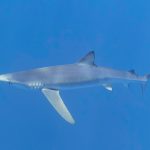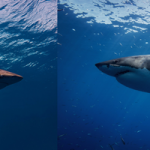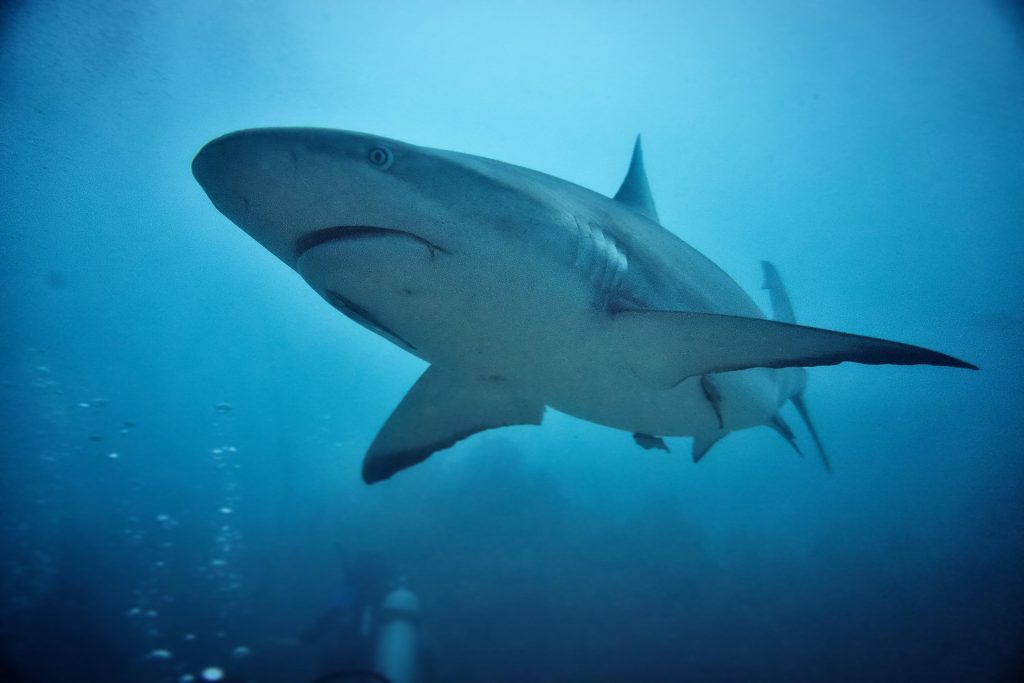
Welcome to the mesmerising depths of the Red Sea, where vibrant coral reefs, steep walls, and eerie shipwrecks form the backdrop to an underwater realm teeming with diverse marine life.
Top sharks of the Red Sea include reef sharks, hammerhead sharks and oceanic whitetip sharks, with lucky sightings of tiger sharks, whale sharks, leopard sharks and thresher sharks when you dive the right location at the right time of year. The Red Sea is a great place to dive with sharks and cheap.
Beyond the colourful tapestry of the Red Sea’s aquatic wonders lies a world of captivating sharks, each with its unique characteristics and allure…some of which are seen on a regular basis at the right time of year (and in the right location of course), whilst others are allusive and seen on very rare occasions.
In this comprehensive guide, I invite you to plunge into the depths and discover the enchanting array of sharks that call Egypt’s Red Sea home. From the iconic Grey Reef Sharks patrolling the reef walls to the elusive Tiger Sharks prowling the open ocean, each species has a story to tell. I’ll unravel the mysteries of Scalloped Hammerheads, marvel at the grace of Oceanic Whitetips, and encounter the gentle giants, Whale Sharks, that grace the northern and southern waters for a fleeting moment each year.
Join me as I navigate the top dive sites, share seasonal insights for optimal encounters, and provide essential pro tips for responsible and exhilarating shark encounters. The Red Sea’s sharks, from the near-threatened Grey Reefs to the critically endangered Oceanic Whitetips, each contribute to the delicate balance of this underwater ecosystem.
Dive into the depths with me, as I not only explore the fascinating world of Red Sea sharks but also emphasise the importance of conservation. As you embark on this underwater adventure, let’s celebrate the diversity, beauty, and fragility of these incredible creatures that make the Red Sea a premier destination for shark enthusiasts.
The best way to encounter sharks of the Red Sea is to book a Red Sea liveaboard trip, which you can do so by choosing your perfect liveaboard either from this window, or by scrolling to a table of Red Sea liveaboards where you can choose your preferences to narrow down the type of liveaboard to suit you.

1. Reef Sharks: Discover the Enigmatic Grey Reef Sharks
Key Facts and Characteristics: Grey reef sharks, along with their counterparts, the black and silvertip reef sharks, are iconic inhabitants of Egypt’s Red Sea. Recognisable by their stocky build and a maximum length of around two meters, these shy reef dwellers frequent the region’s popular dive sites. Their distinct dark grey band along the tail’s edge and a small white tip on the dorsal fin make them easily identifiable.
Encounters and Dive Sites: Encounters with grey reef sharks are common at most of the Red Sea’s renowned dive sites. Beginner divers often have the privilege of witnessing these creatures patrolling reef walls and drop-offs, gracefully navigating easy-going currents. The relative abundance of grey reef sharks in these waters provides an ideal opportunity for first-time shark encounters.
Conservation Status: Despite their frequent sightings, grey reef sharks are classified as “near threatened,” emphasizing the importance of conservation efforts to ensure the sustainability of their population. Responsible diving practices and awareness contribute to the preservation of these captivating reef dwellers.
Pro tips: Perfect for first-timers; observe from a distance.
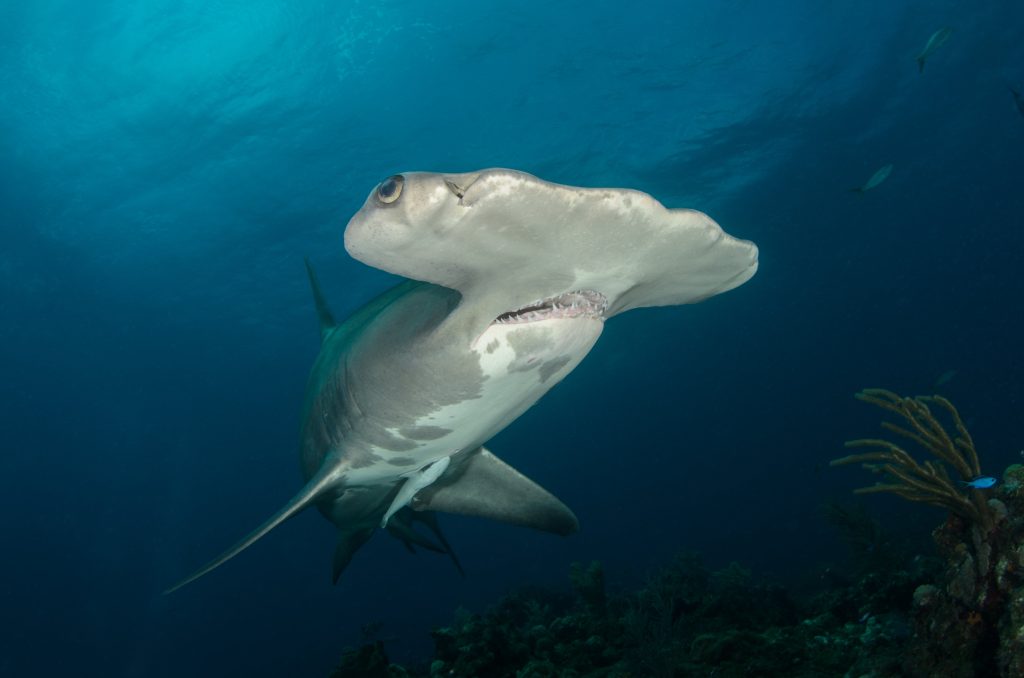
2. Hammerhead Sharks: Marvel at the Magnificence of Scalloped Hammerheads
Key Facts and Characteristics: Scalloped hammerhead sharks, with their uniquely shaped heads, are among the most fascinating species in the Red Sea. Growing up to 3.5 meters in length, these pelagic predators often grace divers with their presence during early morning dives. The Red Sea’s central dive sites, known for fast-moving currents and schooling fish, serve as a playground for dozens of these graceful sharks.
Encounters and Dive Sites: Prime dive sites for encountering scalloped hammerheads include Daedalus, Elphinstone, and Jackson Reef in the Tiran Straits. Seasonal schools gather, creating a mesmerising spectacle, especially from July to September in the north and May to July in the south.
Conservation Status: Scalloped hammerheads are classified as “endangered,” underlining the need for conservation efforts. Divers are urged to approach with silence, as these timid sharks are easily scared off by loud noises.
Pro tips: Approach silently to avoid startling. I saw hammerheads at my favourite Red Sea reef, which is Elphinstone Reef and The Brothers.
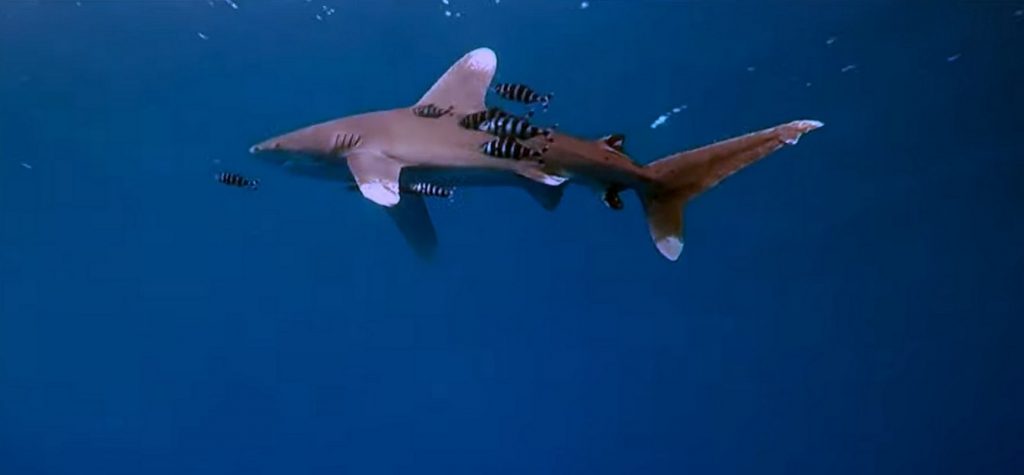
3. Oceanic Whitetip Sharks: Explore the Dynamic Ocean-Goers of the Red Sea
Key Facts and Characteristics: Oceanic whitetip sharks, with their elongated, rounded dorsal and pectoral fins, are dynamic pelagic predators inhabiting the Red Sea. Growing up to four meters in length, these solitary ocean-goers exhibit impressive stature and opportunistic behaviour. Divers can easily identify them by their distinctive rounded white-tipped fins.
Encounters and Dive Sites: Venture to the Brothers Islands, Elphinstone, and St. Johns for a chance to spot oceanic whitetips cruising gracefully in the blue. Encounters are most common between October and January, with sightings reported throughout the year.
Conservation Status: Categorised as “critically endangered,” oceanic whitetip sharks highlight the urgency of conservation efforts. Divers are advised to follow guidelines from dive guides to ensure safe and responsible interactions with these powerful sharks.
Pro tips: Exercise extreme caution around Oceanic Whitetip sharks to ensure safe interactions. These have been know to attack the unwary diver in the Red sea, so be careful, as they are extremely inquisitive and very bold sharks.
4. Tiger Sharks: Unveiling the Elusive Nomads of the Red Sea
Key Facts and Characteristics: Tiger sharks, one of the rarest and most elusive species in the region, patrol the open ocean of Egypt’s Red Sea. With a distinctive striped pattern along their back and sides, these solitary nomads can reach an impressive five meters in length. Tiger sharks employ natural camouflage to approach their prey with great speed and agility.
Encounters and Dive Sites: While tiger sharks are known for their elusive nature, chance encounters can occur at Rocky Island, Safaga, Elphinstone, and around the Straits of Tiran. Unlike other species, tiger sharks are highly nomadic, with no specific season for sightings.
Conservation Status: Tiger sharks are classified as “near threatened,” underscoring the importance of conservation attention. Divers may witness their curiosity but should be ready for brief encounters, as these sharks are likely to move on quickly.
Pro tips: Be aware that to see a tiger shark in the Red Sea is a rare sighting indeed, and you will be really luck to spot one. If you are lucky enough to see one they may not linger for long, so enjoy. In all the dives I’ve done in the Red Sea, I’ve not seen one.
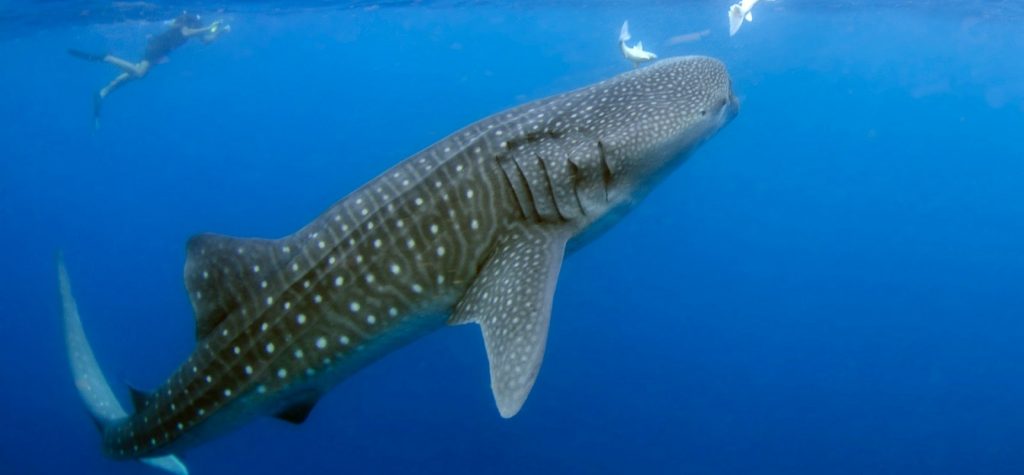
5. Whale Sharks: Dive into the World of Gentle Giants in the Red Sea
Key Facts and Characteristics: Whale sharks, the largest fish in the ocean, grace the Red Sea’s northern and southern regions for a few short months each year. These massive filter feeders, identified by their distinctive spots and patterns, cruise in the shallows, feasting on plankton.
Encounters and Dive Sites: Top dive sites for encountering whale sharks include reefs like Jackson and Woodhouse in the Tiran Straits. Plan your trip between March and July for the most consistent sightings, but always maintain a respectful distance.
Conservation Status: Categorised as “endangered,” whale sharks emphasize the importance of conservation efforts. While tempting, divers should resist reaching out to touch these harmless giants, ensuring both their comfort and safety.
Pro tips: Like with spotting Red Sea tiger sharks, you’ll be extremely lucky to spot a whale shark too, as in all the diving I’ve done in the Red Sea, I’ve not seen one…Yet. If you do see one, maintain a respectful distance for safety and comfort.
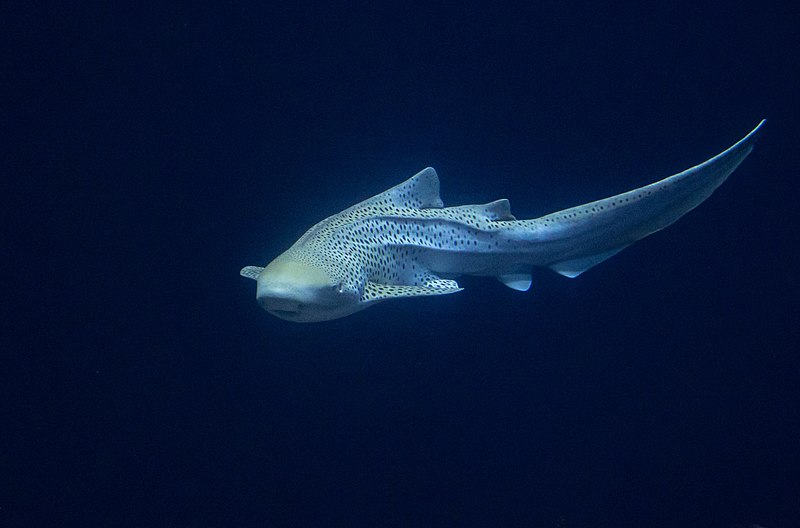
6. Leopard Sharks: Unravelling the Mystique of Zebra Sharks
Key Facts and Characteristics: Leopard sharks, also known as zebra sharks, add a touch of mystique to the Red Sea’s underwater world. These spotted bottom-dwellers are nocturnal creatures. When seen, they are mostly encountered resting on reefs or sand. While mostly observed napping during daylight hours, night divers may chance upon a free-swimming leopard shark.
Encounters and Dive Sites: Leopard sharks are commonly seen in northern sites around Tiran and Ras Mohammed but are present throughout the region. Many liveaboards focus on shark itineraries between May and October, offering the chance of an encounter with a leopard shark.
Conservation Status: Leopard sharks are classified as “endangered,” highlighting the need for conservation awareness. Divers are advised to observe these sleeping sharks from a distance, avoiding flash photography that could disturb their light-sensitive eyes.
Pro tips: If you are lucky enough to spot a leopard shark in the Red Sea, which is a rare sighting, observe from afar and avoid flash photography.
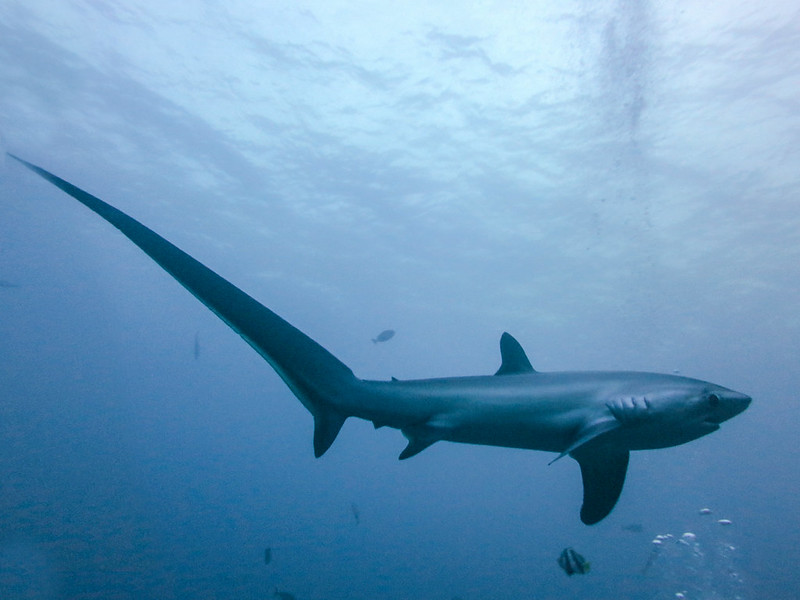
7. Thresher Sharks: Unlocking the Secrets of Red Sea’s Shy and Elusive Predators
Key Facts and Characteristics: Thresher sharks, with their unique appearance featuring massive eyes and a long whip-like tail, captivate divers with their elusive nature. Typically found in the ocean’s depths, these shy predators slowly ascend towards cleaning stations during early morning dives.
Encounters and Dive Sites: Brothers Islands stand out as prime spots for encountering thresher sharks, but they can also be spotted at Elphinstone Reef too, which is where I saw my first thresher shark in the Red Sea. The best chances of an encounter occur from September to February, and divers are encouraged to stay silent and avoid startling these sensitive creatures with light or sound.
Conservation Status: Thresher sharks are classified as “vulnerable,” emphasising the need for conservation efforts. Divers can contribute to their protection by maintaining silence and respecting their natural behaviours.
Pro tips: Understand your chances of seeing a thresher shark is low will manage your expectation. But always be on the early morning dive from the liveaboard, and try to be first in the water, as these shy sharks don’t usually stay around for long once divers are in the water. Maintain silence and avoid startling with light or sound.
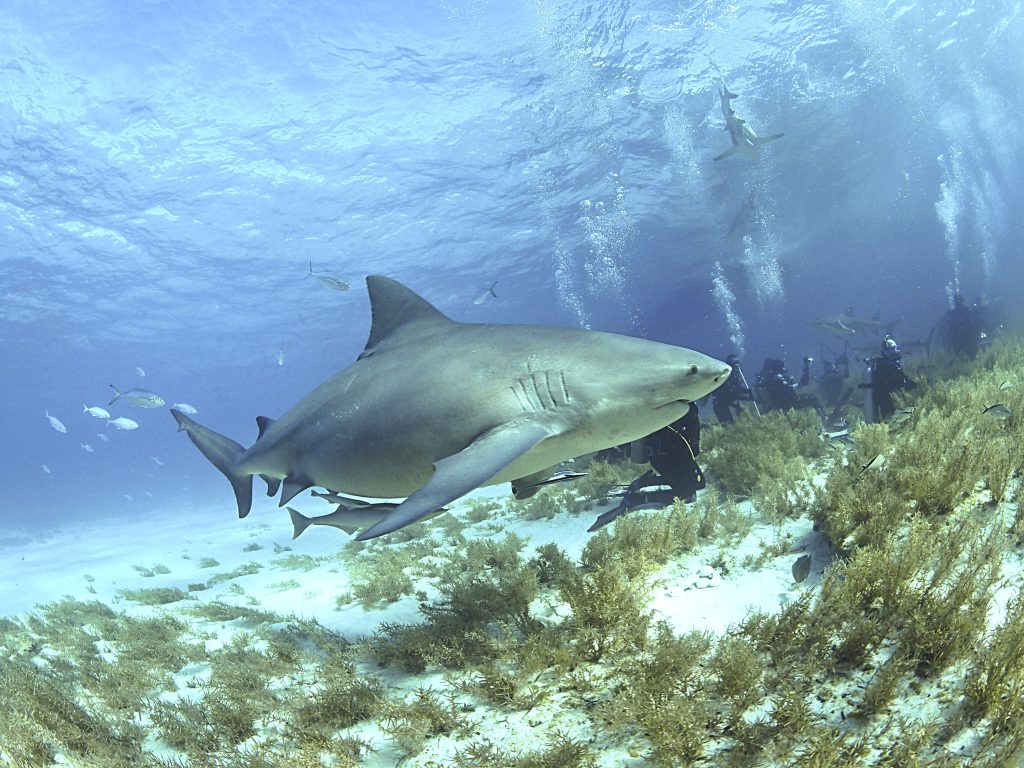
8. Bull Sharks: Less Common But Sometimes Spotted in The Red Sea
Key Facts and Characteristics: Bull sharks, known for their robust build and adaptability and are found in the Red Sea’s diverse ecosystem. With an average length of 2 to 3 meters, these powerful predators boast a unique ability to tolerate varying salinity levels, making them formidable inhabitants of both saltwater and freshwater environments.
Encounters and Dive Sites: Encounters with bull sharks in the Red Sea are rare but exhilarating. Divers seeking these powerful creatures should explore deep-sea locations near Daedalus, Marsa Alam and Elphinstone Reef. Bull sharks are often spotted in the vicinity of underwater caves and steep drop-offs, showcasing their preference for dynamic underwater terrain.
Conservation Status: Bull sharks are classified as “near threatened,” underscoring the need for conservation efforts. Despite their adaptability, factors such as overfishing and habitat degradation pose significant threats to their population. Conservation initiatives focused on sustainable fishing practices and marine habitat protection play a crucial role in preserving these apex predators.
Pro tips: Understand your chances of seeing a bull shark is low will manage your expectation. Be aware the bull sharks are a particularly aggressive shark and like all sharks, they should be respected.
As you dive into the enchanting world of the sharks of the Red Sea, always remember to prioritise responsible diving practices and contribute to the conservation of these magnificent species.
Cherish each encounter, and appreciate the experience of Egypt’s Red Sea.
Find your perfect Red Sea liveaboard
Use the following table to find your perfect Red Sea liveaboard, which you can search by dive sites and other filters to find the liveaboard that suits your level of diving and the location in the Red Sea you want to dive.
| Discover Liveaboard | Customer Reviews | Itineraries | |
|---|---|---|---|
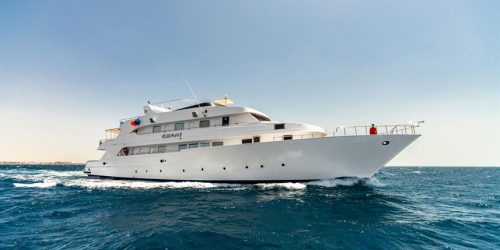 |
Review: MV Ghani; Book: MV Ghani | 10 Exceptional | 8 Days/7 Nights |
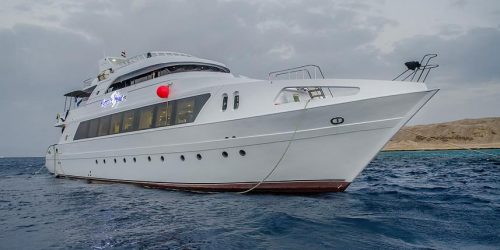 |
Review: MY Hammerhead I; Book: MY Hammerhead I | 10 Exceptional | 6 Days/5 Nights, 8 Days/7 Nights |
 |
Review: MV Andromeda; Book: MV Andromeda | 10 Not rated | 8 Days/7 Nights |
 |
Review: MY Sea Friend; Book: MY Sea Friend | 9.6 Exceptional | 8 Days/7 Nights, 15 Days/14 Nights |
 |
Review: MY Aldebaran; Book: MY Aldebaran | 9.6 Exceptional | 8 Days/7 Nights |
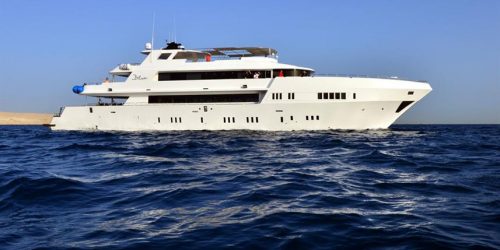 |
Review: MY Blue; Book: MY Blue | 9.5 Exceptional | 8 Days/7 Nights |
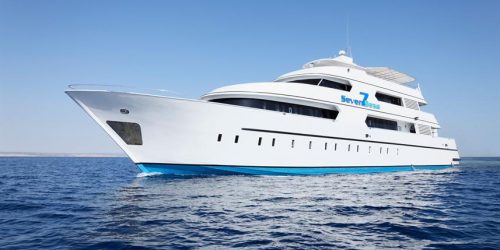 |
Review: MY Seven Seas; Book: MY Seven Seas | 9.5 Exceptional | 8 Days/7 Nights |
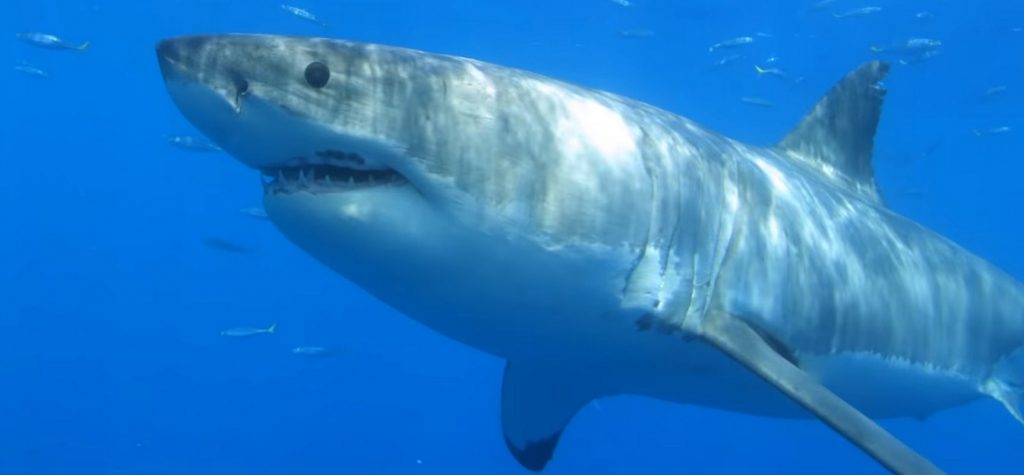
Sharks not found in the Red Sea
The following sharks are not found in the Red Sea:
- Basking sharks – you won’t find basking sharks in the Red Sea as these prefer cooler waters in places like the UK.
- Great white sharks – Great white sharks are not found in the Red Sea, as the waters are too warm for them, as great whites prefer water temperatures between 12-24°C (54-75 °F).
- Blue shark – You won’t find blue sharks in the Red Sea as these live in oceans like the Atlantic.
- Sand tiger shark – The sand tiger shark is not found in the Red Sea, as these sharks prefer cooler waters in places like the northern Atlantic Ocean.
I hope you enjoyed this article about sharks of the Red
I’d love to hear from you. Tell us about your adventures of diving and snorkeling, in the comments below. Please also share your photos. Either from your underwater cameras or videos from your waterproof Gopro’s!
If this article hasn’t answered all of your questions. If you have more questions either about snorkeling or types of scuba diving (or specifically about sharks of the Red Sea), please comment below with your questions.
There will also be many more articles about scuba diving (and snorkeling) for you to read and learn about these fabulous sports.
Have fun and be safe!


